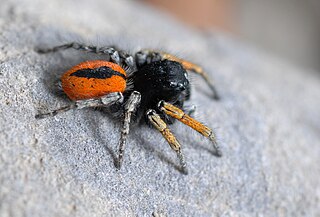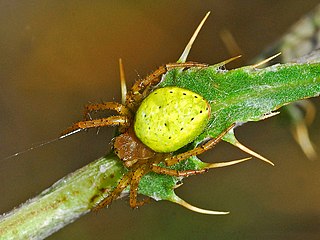
The spider species Tegenaria domestica, commonly known as the barn funnel weaver in North America and the domestic house spider in Europe, is a member of the funnel-web family Agelenidae and a close relative of the hobo spider.

Xysticus is a genus of ground crab spiders described by C. L. Koch in 1835, belonging to the order Araneae, family Thomisidae. The genus name is derived from the Ancient Greek root xyst, meaning "scraped, scraper".

Philaeus chrysops is a species of jumping spider (Salticidae).

The raft spider, scientific name Dolomedes fimbriatus, is a large semi-aquatic spider of the family Pisauridae found throughout north-western and central Europe. It is one of only two species of the genus Dolomedes found in Europe, the other being the slightly larger Dolomedesplantarius which is endangered in the UK.

Steatoda nobilis is a spider in the genus Steatoda, known in the United Kingdom as the noble false widow and is often referred to as the false widow. As the common name indicates, the spider superficially resembles and is frequently confused for the black widow and other spiders in the genus Latrodectus. S. nobilis has medically significant venom, where in England, it has a reputation as one of the few local spider species that is capable of inflicting a painful bite to humans, with most bites resulting in symptoms similar to a bee or wasp sting.

Misumena vatia is a species of crab spider with holarctic distribution. In North America, it is called the goldenrod crab spider or flower (crab) spider. It is commonly found hunting in goldenrod sprays and milkweed plants in the autumn. They are called crab spiders because of their unique ability to walk sideways as well as forwards and backwards. A female's torso can grow up to 10 mm (0.39 in) while males are quite small, reaching 5 mm (0.20 in) at most. These spiders are yellow or white, and have the ability to change between these two colors based on their surroundings. They have a complex visual system, with eight eyes, that they rely on for prey capture and for their color changing abilities. Sometimes, if Misumena vatia consume colored prey, the spider itself will take on that color.

Micrommata virescens, common name green huntsman spider, is a species of huntsman spiders belonging to the family Sparassidae.

Tetragnatha extensa is a species of spider found across the Northern Hemisphere. It has an elongate body, up to 11 mm (0.43 in) long, and adopts a straight line posture when alarmed. It lives on low vegetation in damp areas, and feeds on flying insects which it catches in its web.

Pardosa amentata, otherwise known as the wolf spider or spotted wolf spider is a species of spider in the genus Pardosa belonging to the family of wolf spiders, Lycosidae. The species has a widespread distribution in central Europe and northwestern Europe and are commonly found on the British Isles. The species hunts its prey on the ground rather than weaving a web.

Ozyptila trux, the yellow leaflitter crab spider, is a crab spider species with Palearctic distribution.

Indoxysticus is a genus of Asian crab spiders that was first described by S. P. Benjamin & Z. Jaleel in 2010. As of September 2020 it contains three species, all found in Asia: I. lumbricus, I. minutus, and I. tangi. The genus differs from others in its family by the oval-shaped spermathecae with well-defined chambers in females and by the broad-based embolus in males.

Pardosa monticola, or pin-stripe wolf spider, is a species of wolf spider found mainly in Europe. It is found in both dry and humid habitats, and up to an altitude of 2000m.

Trochosa spinipalpis is a specialised species of Palearctic, wolf spider which is restricted to bogs and other wetlands.

Xysticus cristatus, the common crab spider, is a European spider from the family Thomisidae.

Zora silvestris is a prowling spider in the family Miturgidae which is found in Europe and central Asia.

Philodromus aureolus, the wandering crab spider, is a mainly European running crab spider of the family Philodromidae. The taxonomy of the species group named after Philodromus aureolus is in a state of flux and a number of new species have recently been recognised.

Micaria pulicaria, the glossy ant spider, is a species of ground spider from the family Gnaphosidae with a Holarctic distribution.

Tetragnatha montana, commonly known as the silver stretch spider, is a species of long-jawed orb weaver from the family Tetragnathidae that has a Palearctic distribution. It preys mostly on flies and mosquitoes. The name silver stretch spider refers to its shiny metallic colour and its habit of extending its legs into a stick like shape.
Xysticus elegans, the elegant crab spider, is a species of spiders found in the USA, Canada and Alaska.

Araniella opisthographa is a species of orb weaver in the spider family Araneidae.



















